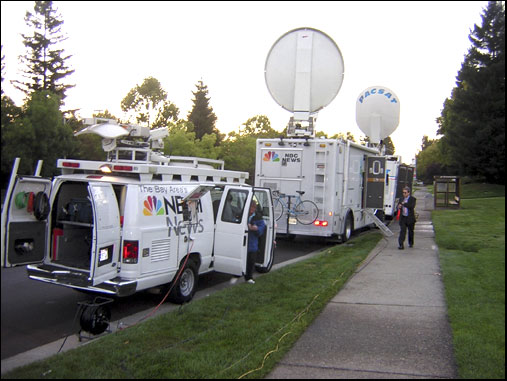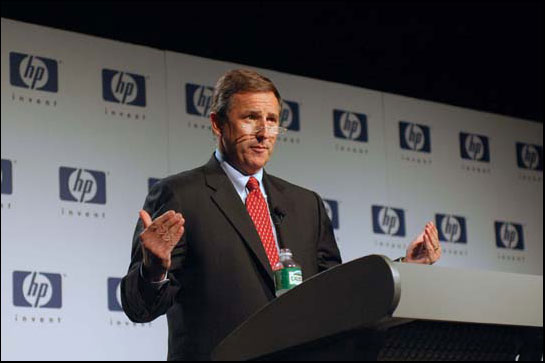THE TROJAN HORSE
By Mark Neuling
Staff News Photographer CNBC
There was something
ironic at work here. The pretty reporter slumped into the seat
next to mine and seemingly to no one stated, “ A broadcast
journalist without a camera, only a cell phone.” The she
held up the little camera phone and muttered, “Not even
a zoom.” All the while I continued to stare at the bag
of lenses at my feet that I had raced home to get a few hours
before. Lenses whose lineage I could trace back to well into
the past century, a couple of which I had owned for longer than
I’ve known my wife.
It had been another start before dawn. It was surprising how few trucks were
going live what with all the build up this story was getting. Computer
giant Hewlett-Packard was in world of trouble. In an effort to find out
who was leaking information from their boardroom they had hired some outside
investigators who in turn may have illegally obtained phone records of
board members, HP employees and heaven forbid, spied on journalists. Around
Silicon Valley it’s being called a scandal, a breech of ethics for
the company that set the ethical bar in the valley; and of course the media
has tagged it as HP-Gate. And as many of you may have seen, the story has
moved into the halls of Congress.
Our first live shot was postponed an hour. The plan was for me to cover the
early live shots and then cover the 1:05 p.m. “press conference.” A
press conference that was conveniently scheduled to start 5 minutes after
the markets closed for the weekend back east and just so happened to coincide
with Rosh Hashanah.
As the late summer sun crept across the horizon I set up a silk and adjusted
the lights I had set up in the darkness hours before. About then things
really began to heat up. Word was the HP was not going to allow television
cameras in. Still cameras would be allowed, albeit without flash and there
would be no questions allowed from the press. Maybe Dick Nixon was alive
and well in the darkened alcoves of HP orchestrating this public relations
mess.
.
And about then someone on the television side of the fence got the bright idea
that maybe we could shoot stills of this presser, and guess who got the call?
Well I do quite often carry a small point and shoot camera, which I use to
take pictures of our crews out on the various locales that we go live from.
But a point and shoot wouldn’t cut it for this kind of work so back
home I went to fetch the SLR’s. Consumer grade digitals, good for
vacations and to record my daughter growing up, but not the high speed,
RAW, meat eating Canons and Nikons that the professionals use. Remember
my tool of trade shoots 30 frames a second, sits upon a big black tripod
and records on to DVC-Pro videotape. Once we’re set up television
has an almost languid, sleepy pace compared to stills.
But there I sat, in the second row, staring at the well manicured toenails
of one of local televisions finest, checking and double checking the ASA
and white balance settings of my two little cameras.

© Mark Neuling
Network satellite trucks and local microwave vans wait
outside of Hewlett-Packard's headquarters on Friday morning
Sept. 22, 2006. |
|
HP
was really being very accommodating to the media considering
the gravity of the day. They had allowed the sat-trucks of
the networks and microwave vans
of the locals to set up shop in their parking lot. While the assembled journalists
waited in the lobby, there were cookies, fruit and water eagerly consumed
by the assembled media representatives. When it comes to free food, ethics
be damned, the media will devour anything in sight like locusts from a Biblical
plague. But I digress and the press conference by HP’s CEO Mark Hurd
was about to begin. |
A spokesman came out first and made some opening statements. A few of us tested
our cameras and checked our settings. I’d been told that the lights
were going to be brought up, but only at one point during the event did they
rise only quickly to be faded down. It was pretty dark; thank goodness I’d
invested in those good lenses years earlier, before marriage, a kid and home
ownership. |

©2006
Mark Neuling for CNBC
HP's CEO Mark Hurd, at the podium, is introduced by a spokesman. |
|
Mr. Hurd took the stage. We raised our cameras to eye level and fired away.
Every time he looked up from his statement or gestured there was the
rapid fire staccato of camera shutters clicking away. I seemed to be
a fraction of a second behind the other, more experienced photographers;
in fact I was taking my cue of when to shoot from the sound of their
shutters. After one burst from my main camera it froze, ERR flashed across
the screen and nothing I tried would revive it. I scrambled back to my
seat and grabbed my second camera and continued on. As soon as the beleaguered
Mr. Hurd finished I left and headed back up the hill to our bureau, just
a few short blocks from the HP campus.
Earlier that morning I had stopped by the office to see if I could in fact
even download images from a card reader into my computer, not a procedure
that is a normal part of my work flow. If I couldn’t do it this whole
experiment would go up in smoke. Up until about three months ago the computers
we had at work were pretty antiquated, the operating systems that were
so old and so slow I wouldn’t have even attempted to download and
edit pictures. Fortunately our IT department, in all their wisdom, had
shipped out new computers with relatively up-to-date software and email
accounts. When I plugged the card reader into the USB slot, lo and behold
there were the test photos I’d taken at office. From there I could
send them out in an email.
|

©2006
Mark Neuling for CNBC
HP's CEO Mark Hurd begins his press conference. |
|

©2006
Mark Neuling for CNBC
HP's CEO Mark Hurd makes
a point. |
|
What can I say? Everything
worked the way we’d hoped it would. I got
back to the office. downloaded my cards and started sending out emails. Because
of the size of the files I’d only send 4 or 5 jpegs out with each one.
There wasn’t enough time to crop, tone or resize anything – just
send them out so that they’d get on air as fast as possible. Our news
associate began to get phone calls; at least they left me alone, had I sent
anything out yet to CNBC’s headquarters in New Jersey? Then the call
came that NBC Nightly News also wanted some shots, more emails to send, which
my computer laboriously crunched. I began to organize the best shots into a
file. At least now I wasn’t sending things out blindly. We weren’t
concerned with quality, just speed.
Some time passed, I just happened to glance up at one of the dozen or so monitors
we have around the studio. A familiar shot flashed by, followed by several
more. Someone in New Jersey had done a pretty good edit from the limited
shots I’d so hurriedly fed back east less than an hour before. The
network news also used some photos that night on their coverage of the
HP story.
So what’s the lesson in all this for both television and still photographers?
I guess it’s just to be prepared, you just never know when the platypus
may be called upon to be a Trojan horse.
© 2006 Mark Neuling
The opinions expressed are solely those of the author.
Email address is now – theneulings@Juno.com





